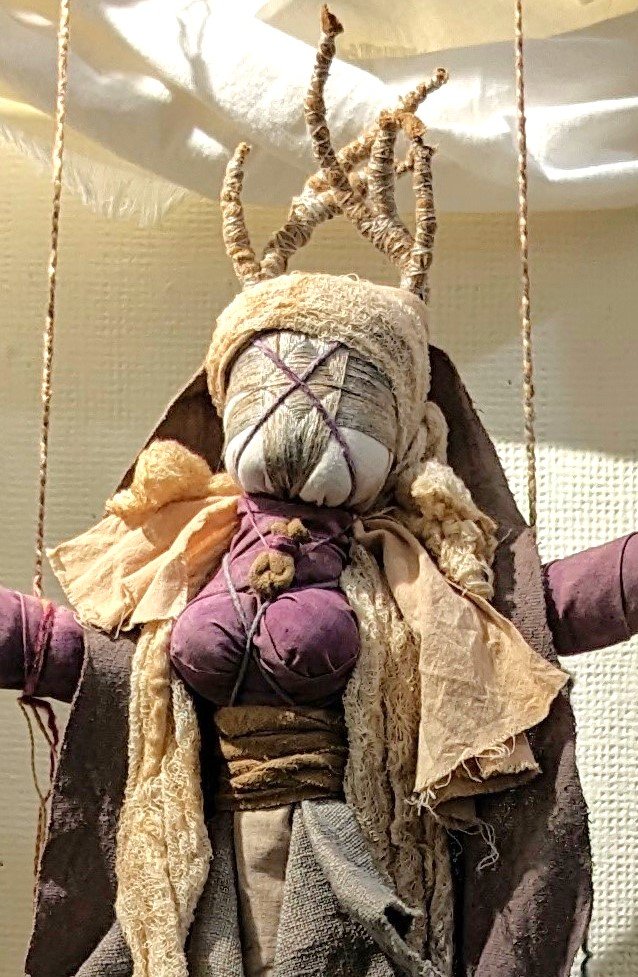Nikki Manzie’s exquisite exhibition, “THE LAND DREAMS IN CEREMONIES: REPARATION,” opened on March 7, 2024. As a representative of the Ukrainian diaspora, her creations embody a profound connection to her heritage. Central to Manzie’s artistry is a poignant plea for the protection of nature and the environment in its broadest essence. Drawing from years of experience and meticulous research, the exhibition serves as a testament to her dedication to restoring the symbiotic relationship between humanity and the natural world. Manzie’s work also celebrates the preservation of traditional ethnic elements and the cultural and spiritual values of the Ukrainian people. With a keen eye for detail, she intricately weaves together folk crafts and traditions, infusing them with her unique artistic flair. Each piece on display reflects the passage of time through the lens of the ancient lunar calendar, spanning 13 months. Through sacred imagery and symbolism, Manzie masterfully conveys the deep interconnection between humans and their environment. Her ability to seamlessly integrate historical, ethnic, and spiritual traditions into her art not only holds profound cultural significance, but also exerts a therapeutic influence on the viewer.
“The technique of their execution, combined with elements of pysanka and textiles, testifies to the author’s deep feeling and understanding of the original source of national traditions.“
At the exhibition, the artist unveils a mesmerizing array of traditional dolls, a cherished facet of Ukrainian cultural heritage. What distinguishes the master’s craftsmanship is her meticulous preservation of performance traditions, crafting each piece with reverence and skill. Drawing inspiration from the iconography of folk dolls, particularly emblematic of Ukraine’s cultural heritage, especially the Central Dnipro region (central regions along the banks of the Dnieper), Ms. Nikki imbues her creations with a harmonious blend of authenticity and creativity.
Remarkably, Nikki pays homage to several specific folk arts simultaneously: doll making, pysanka (the art of decorating eggs), and textile work. Pysanka, alongside the knotted doll, stands as a cornerstone of Ukrainian culture, carrying profound symbolism and historical significance. With masterful technique, Ms. Nikki resurrects the traditional craft of pysanky, infusing it with her own artistic vision and folk motifs. The metamorphosis of an egg into a pysanka, symbolizing life, not only embodies a material representation, but also underscores a spiritual understanding of culture. When coupled with the doll, a profound synergy emerges, each element complementing the other in a symphony of symbolism and aesthetics.
It is impossible to pay attention and choose the finest textiles. Hand-embroidered fabric gives to the creations, not only authenticity, but also a special charm.
As a master and successor of the people’s doll, I would like to cover the dolls of Ms. Nikki in more detail. They based on the traditions of folk art in Ukraine. Relying on the previous works of M. Grushevsky and the historical paintings of Avdeev, we can confirm that such iconography would be most characteristic of the central regions of Ukraine. In the performances of Maistrin’s dolls one can sense the ancient source. They can serve as a viscous thread between the past and today. Their current appearance is both archaic and modern. Which can indicate Ms. Nikki’s deep understanding of the cultural and historical value of the folk doll, the importance of its preservation and creation. Each doll contains traditional elements, part of the national heritage phenomenon.
If you look at the structural composition and iconography of the dolls from the exhibition, you can see that the author has given great respect to the main structural elements of the folk doll. An important element that the folk dolls see, and especially from the Central Dnieper region, is the particular design of the appearance. It can be “clean” (without facial features), with facial features (toy dolls) or with a cross. The cross on the face of the doll testifies to its archaic and ancient image. Such dolls primarily had talismanic and ritual significance, and over time acquired a game function. Ms. Nikki, from the understanding of traditional foundations, has come to the creation of these elements, which are important not only in aesthetic, but also in cultural significance.
It is impossible to ignore the question of the art therapeutic effect of the doll. According to O. Nayden’s scientific research, the folk doll first had a ritual significance; therefore, it had a certain psychological impact on a person. Today, the same dolls can be used to provide psychological support to a person. The design of the dolls presented at the exhibition is quite suitable for this purpose.
Summing up, I would like to say: Ms. Nikki’s dolls reflect ancient Ukrainian traditions. The technique of their execution, combined with elements of pysanka and textiles, testifies to the author’s deep feeling and understanding of the original source of national traditions.
Olena Kornienko
Accredited Master
Union of Folk Craftsmen of Ukraine


